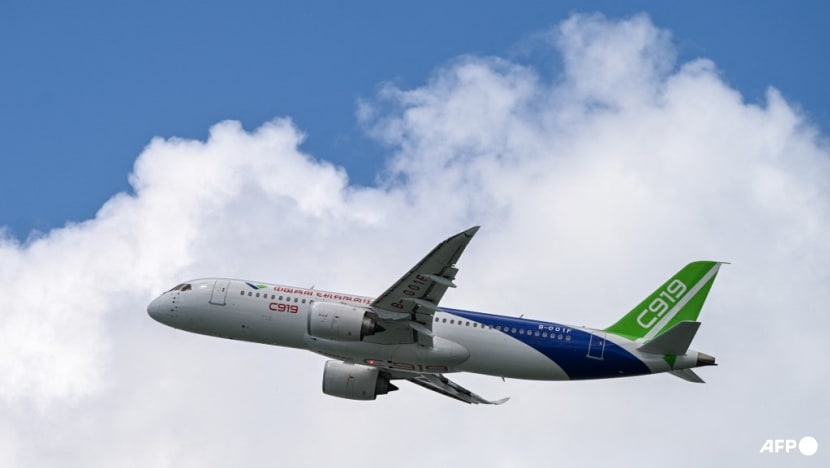Chinese planemaker COMAC's long journey to go global
China is aiming for self-reliance and to break the Western duopoly of Boeing and Airbus with the debut of its C919 jet.

China's Comac C919 airplane flies past during the Singapore Airshow in Singapore on Feb 20, 2024. (Photo: AFP/Roslan Rahman)

This audio is generated by an AI tool.
Aviation is one of China’s fastest growing industries, and the nation is forecast to become the world’s biggest aviation services market by 2042.
Two big players currently dominate the commercial jet manufacturing space – United States’ Boeing and France’s Airbus.
China’s homegrown planemaker Commercial Aircraft Corporation of China (COMAC) is trying to be a viable competitor with the debut of its C919 jet.
Chinese President Xi Jinping called the aircraft a “triumph of Chinese innovation” when its first jetliner took to the skies.
According to the Center for Strategic and International Studies, a US think-tank, Beijing spent up to US$72 billion in state-related support to build the C919.
China is aiming for self-reliance and to break the Western duopoly of Boeing and Airbus.
The Civil Aviation Administration of China (CAAC) plans to build an extra 200 airports by 2035 to keep up with air travel demand.
Boeing reckons China would need about 8,560 new passenger jets up in the air over the next 19 years, in a market worth a whooping US$2.9 trillion.
But China’s route to the C919 taking flight has been a long and expensive one.
THE RUNWAY TO TAKE FLIGHT
State-owned manufacturer COMAC was established in Shanghai in May 2008, with an aim to build the nation’s own jetliner and reduce its dependency on foreign plane makers.
Two years later, COMAC applied to the CAAC for certification of the C919.
In November 2010, it announced its first order of 100 planes from the so-called ‘Big Three’ Chinese airlines – China Southern, China Eastern and Air China – and leasing companies.
COMAC announced a few years later that the C919’s first flight would be delayed until 2015, with delivery dates pushed back to 2018.
More delays later, the C919 finally took flight in May 2017. A second prototype made its maiden flight in December the same year.
In 2022, the CAAC issued the airworthiness of the C919 after testing six prototypes.
Last May, the C919 completed its first commercial flight to Beijing from Shanghai, operated by China Eastern Airlines.
HOW DOES THE C919 COMPARE?
The C919 measures almost 39m in length, with a height of nearly 12m. It is longer and taller than the Airbus A320, but shorter than the Boeing 737-8.
In terms of capacity, the Chinese aircraft is able to seat more passengers than the other two, carrying up to 192 people.
However, it has a smaller flight range and fuel capacity, compared to the Airbus and Boeing jetliners.
NOT SO MADE-IN-CHINA
While the plane may be labelled ‘Made in China’, most of its parts, including the engine, are not.
COMAC has been working hard to find an alternative to the LEAP engine, manufactured by CFM International, a consortium between American GE Aerospace and French Safran Aircraft Engines.
In addition, the aircraft’s avionics and control systems are American, while its landing gear is German.
State-owned Aero Engine Corporation of China (AECC) is already busy developing the CJ-1000 high-bypass turbofan jet engine to replace the LEAP engine.
Certification could come as early as next year, according to Chinese media.
WHO’S BUYING THE AIRCRAFT?
The majority of the take-up for the C919 has been from Chinese airlines.
Brunei’s GallopAir is the first foreign airline to order the plane, while Indonesian carrier TransNusa is considering purchasing it after its success with COMAC’s smaller ARJ-21 jets.
Analysts said it is only a matter of time – but likely decades – before COMAC can really fly as high as the Airbus-Boeing duopoly.
“It could take another two to three decades in order for COMAC to ramp up their production rates, expand their ground support and maintenance support in other locations,” said Mr Herman Tse, a valuations manager from aircraft analytics and consultancy firm Cirium Ascend.
“However, if there are no parts, no component support, it will be very difficult for this aircraft to go international,” he told CNA’s East Asia Tonight programme.
China’s aviation industry faces increasing export control restrictions from the US over alleged military ties.
This has prompted a sense of urgency for Beijing to develop its own parts, particularly the engine, to mitigate the risks of relying on western suppliers.
WILL THE C919 TAKE OFF GLOBALLY?
Mr Tse added that aside from production, certification is key to taking off internationally.
It took Airbus and Embraer around 30 years to mature, and certification from the US Federal Aviation Administration is essential to succeeding.
China’s civil aviation authority is already making it a priority to obtain European certification for the C919 by next year.
Meanwhile, China still needs to purchase aircraft from foreign manufacturers to meet air travel demand, with Airbus in talks to sell over 100 wide body jets to Chinese airlines.
COMAC is expected to manufacture 150 C919s annually over the next five years, a small number compared with Airbus and Boeing, which delivered 735 and 528 respectively last year.
Chinese carriers have reportedly already put in more than 1,000 orders for the C919.
“Its production rate is not that ambitious. No doubt the aircraft will go international in the longer term, but in the shorter term, because of the low production rates, the focus is on the domestic market,” Mr Tse said.
He added that he expects the Belt and Road countries, which have good diplomatic relationships with China, to be the first international buyers of the C919 in the future.




















